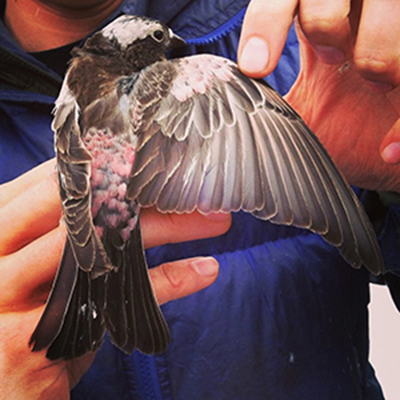Evaluating the Distribution of Nesting Black Rosy-finches in Northwestern Wyoming
Black Rosy-finches (Leucosticte atrata) in Wyoming breed exclusively in alpine environments where snowfields and alpine tundra facilitate foraging and cracks in cliffs provide nest sites, making them vulnerable to habitat changes caused by climate change. This is one of the least studied species in North America; only an estimated five parties have documented finding nests.
Project Overview

Black Rosy-finches are listed as a Tier II NSSU (U) species by the Wyoming Game and Fish Department. While occupancy status is known for many mountain ranges in Wyoming, it remains unclear or undocumented in others. Black Rosy-finches are high elevation obligate nesting birds, and their residency is closely tied to snowpack, so data are needed to assess future risk from climate change and to develop long-term monitoring protocols.
Project Components

BRI biologists will survey sites in mountain ranges of northwestern Wyoming for evidence of breeding. An emphasis will be placed on historic or suspected breeding sites with summits that approach the lower end of elevations known to support Black Rosy-finches to investigate the effects of climate change. We will also visit ranges where breeding status is unknown or poorly documented to assist local managers in identifying the range of the species.
Spring captures of migrating Black Rosy-finches arriving at feeders will facilitate banding and sampling of birds. Color bands will help identify spring site fidelity and movements in the region, and will create the potential for identifying wintering sites. Surveys to locate nesting sites will help determine research sites for future study.


